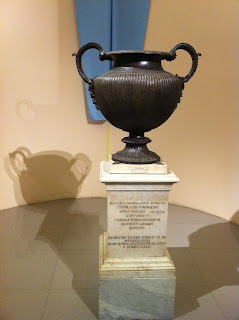Wednesday, November 16, 2011 -  conservation,Julia Brennan,textiles,Turkey,Washington DC
conservation,Julia Brennan,textiles,Turkey,Washington DC
 No comments
No comments
 conservation,Julia Brennan,textiles,Turkey,Washington DC
conservation,Julia Brennan,textiles,Turkey,Washington DC
 No comments
No comments
Revisiting the Turkish Residence – The Ballroom’s “Ottoman style” Wall Fabrics
 |
| The Turkish Residence |
By Julia M. Brennan
ARCA Washington DC Correspondent
This story is not about art theft or repatriation, rather it is a preservation account of a monumental project to conserve part of Turkey’s and Washington D.C.’s shared history.
Recently I had the honor of attending a lecture about the Perge excavations at the Turkish Residence in Washington DC. We gathered in the elegant ballroom, whose walls are covered with sumptuous arabesque and floral red and gold silk textiles. They are not just ‘wall fabric’, but architectural textiles; characterized by two-dimensional niches executed with a syncopation of color, pattern, and rich floral details. People wonder if they are painted, leather, old or new. The whole room radiates from the Ottoman-style wall fabrics. They draw you into a dance around the room, over gilt mirrors and carved doorways, the red and gold niches of red and gold silk vases, with flickers of subtle embroidery. They speak to another era and taste. In 2002, the Turkish Government launched a complete restoration of the mansion – every architectural, structural and decorative detail was addressed. I was given the contract to clean and conserve these fabric treasures. Four years later, when the renovation of the entire mansion was complete, the fabrics were reinstalled, restoring the original Ottoman-style sumptuous character to the ballroom. It was a stunning backdrop to the Perge lecture, and personally very gratifying to see the textiles beautifully restored, as they might have looked in 1914 when they first graced the ballroom.
1606 23rd Street NW was an eccentric and extravagant mansion when it was completed in 1914. Commissioned by Edward H. Everett, a Cleveland millionaire, philanthropist and industrialist, who like many barons, needed a Washington DC base for societal and political reasons. He had interests in oil, beer, and huge glass productions. Everett was the inventor of the ‘crimp’ bottle cap, made famous by Coca Cola. During the Everetts’s residency, their home was the scene for many parties, including musical events in the ballroom, “including singers from the Metropolitan Opera.” (The Sunday Star 9-9-56) His second wife, Grace Burnap, was an amateur opera singer. The house was a gem of The Gilded Age, encrusted with elaborate marquetry and parquet flooring, marble entrance hall, Mannerist paintings, Flemish tapestries, Oriental carpets, a stained glass conservatory, an Otis elevator and the first indoor swimming pool in the city. The 1915 tax assessment was $280,000. (The original building estimated that the cost of building would be $150,000.) No expense was spared.
The architectural design and interior decorations were entrusted to architect George Oakley Totten Jr (1866-1939). His international background and keen interest in architectural ornamentation, produced many lavish Embassy Row homes, combining Oriental and Occidental styles. He designed and built over 16 houses in Washington DC. Totten spent three years at the Ecole des Beaux Arts (1893-1895), lived and worked in Rome, Vienna, Madrid and London, and in 1908 resided in Turkey where he designed the American Chancery and a residence for the Prime Minister. Sultan Abdul Hamid offered him the position of ‘private architect to the Sultan of Turkey’, but the 1909 overthrow of the Sultanate ended that commission. Totten brought to his Washington projects all the elements of his exotic and romantic life, including probably the actual silk wall hangings in the ballroom. No doubt, working for the Sultan, he was exposed to the tradition of ceremonial tent hangings, exquisite Ottoman architectural textiles adorning houses and transitory encampments.
 |
| The Ballroom in 2003 |
In 1932, after the death of Mr. Everett, the Turkish government established their embassy at the Totten ‘palace’. The house was still pristine, and in it’s hey day, a gem of Washington ‘status’ architecture along the Massachusetts Avenue corridor. The Turks acquired the house with all the architectural and decorative décor, “buildings and furnishings” including paintings, fireplaces, wall coverings. Just after the Great Depression, the home was priced to sell. The Honorable Munir Ertegun served as the first Ambassador from the newly formed Republic of Turkey. His sons grew up in this house and in an avant garde musical environment. One of the Ambassador’s sons, Ahmet Ertegun, is known for founding Atlantic Records and signing the Rolling Stones. Given Ahmet’s charisma and love of music, he must have fallen in love with the ballroom with it’s elevated stage, Italianate windows and inset mirrors, gold and blue rinceau-panelled ceiling, carved rinceau double doors, and sumptuous gold and red silk Ottoman walls. It was an over-the-top blend of styles and textures, a perfect place to hold ground breaking jazz concerts hosting Duke Ellington, Cab Calloway, Lena Horne, and other Washington DC music greats. During the Ertegun period, the grand life of the ballroom continued with a renewed style and sound. In segregated Washington DC, local newspaper society columns at the time gossiped and criticized the frequent flow of ‘Negroes using the front door’ of the residence.
In 1999 the house became the Ambassador’s Residence, and after nearly 100 years it was suffering from both structural and decorative damage.
Reference:
“Massachusetts Avenue Architecture, Volume I”, Issued by The Commission of Fine Arts, Washington D.C. , 1973, pgs. 317-346
The next two blog posts will continue the story with the conservation of the wall fabrics.
Julia M. Brennan





















